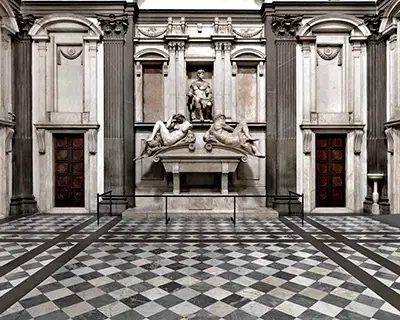The tomb of Giuliano di Lorenzo de' Medici features Michelangelo's Night and Day, whilst his Dusk and Dawn can be found in the tomb of Lorenzo di Piero de' Medici. It was very common within this artist's career to work on planned tombs and there would often be multiple phases to each project, which would sometimes require the aid of several different sculptors when things dragged on over the course of many years. Additionally, these great names would also employ some of their own staff for some of the more menial tasks, whilst ensuring that they managed the project and kept standards as high as their own. This approach enabled the likes of Michelangelo to constantly acquire more work and avoid becoming stuck for an extended period on the same work.
Those knowledgeable on Italian art will be aware of Brunelleschi's Sagrestia Vecchia which itself was completed in 1440 and would have provided a basis from which Michelangelo could plan this design around a century later. It is known that Michelangelo was not experienced with architecture at the time of his work on the New Sacristy, with many projects following on afterwards once his reputation and stories of success on this project would have spread around. Politics was also key to acquiring prominent projects and Michelangelo himself became skilled in dealing with patrons and promoting his own reputation. It is believed that this master did not actually install any of the sculptures himself, but had left the city by the time that Niccolò Tribolo installed them in 1545. Two further planned tombs were never completed.
It is highly enjoyable to see how this great master would transition over the course of his career, from a draughtsman, to a sculptor and then moving into architecture. Few men have ever been able to achieve such success across this plethora of disciplines, though Da Vinci can be said to have competed strongly with his own paintings and inventions. That is why they have both become known as true Renaissance men, rather than simply as highly skilled specialists. Work was far more localised then than it is now, and so Michelangelo's decision to relocate to Rome would mean that his work here was essentially done, meaning any further tasks such as actually placing the items into the final positions would have to be done by someone else. On other projects, Michelangelo would even leave projects completely unfinished, as indicated by a number of annulled contracts which have surfaced since.


